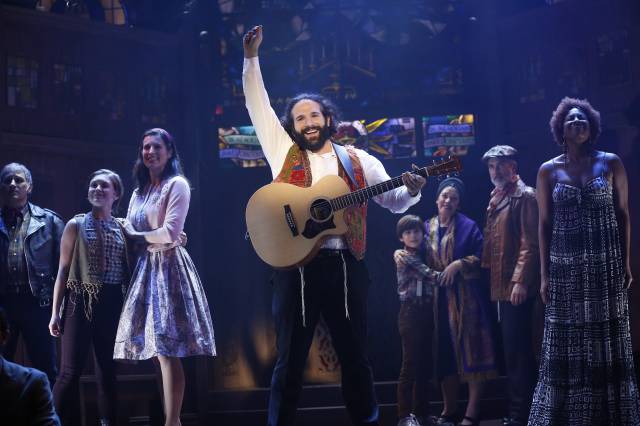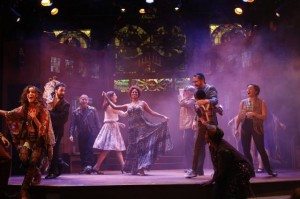

Soul Doctor, the somewhat biographical musical of rebel rock star Rabbi Shlomo Carlebach is poised for its official Off-Broadway opening on Sunday, December 14, at The Actor’s Temple. Now revamped and reimagined as a one-act using the songbook of Carlebach and lyrics by Carlebach and David Schechter, the production has had quite a journey to its current incarnation including various regional productions and two months on Broadway at Circle in the Square Theatre (2013).
After a recent preview performance, I had the pleasure sit down and chat with the production's director, Mindy Cooper, and find out a little more about the journey of Soul Doctor.
Mindy, you have had an association with Soul Doctor for some time but in other capacities. Having seen the show go though other incarnations what drew you to this piece as a director?
Personally, [this show] spoke very loudly to me; the music, the cadences, the families in the story. So it was a no brainer to say yes and then to try to bring it to light and reach as many people as we could. It is an important message. And there is a huge audience that can find this show, love this show and come away clapping and feeling the essence of this music, what it can do and where it can transport you.
I was onboard at New York Theater Workshop. I thought [the show] was long and needed some trimming. So I said, “yes, if it's shorter.” I was very adamant about it being a one act; get in, tell some story, sing some gorgeous songs that aren’t too long and get out. Leave them wanting more.
What is it like to take on the Off-Broadway version of a show that already had a prominent commercial production?
Every show that comes to Broadway has a gestation period of about 7 years, so for me to breathe new life into this one was a bit hard because there have been so many iterations of it. I’m lucky because there are so many things that worked before that I can expand upon. There’s also a lot of stuff that worked that you have to make go away because you can’t do a three-hour musical. You know the old expression, “kill the baby”. You have to be pretty brutal sometimes. “It is wonderful, it's beautiful but we don’t need it, it doesn’t further the plot.”
I knew [coming into this] I wanted it to be a streamlined production with an eye toward touring it. So I wanted to make it a self-contained piece.
I can see that this production would work very well in a variety of different touring venues. This particular production performs in an active temple, how has that influenced your design and staging choices?
When I came on board, Dr. (Jeremy) Chess (producer) had already procured this space. I came in and said, “Are you kidding? Fifteen people aren’t even going to fit on that stage.” We butted heads but then I began to embrace it.
This is a synagogue but it's also a theater, it's been a theater for many years. When I came in with my designers, blacks were hung all over the space so the beauty of the space was all covered up. We hit on the idea to strip the blacks away and set [the story] in the synagogue. So we open the show in the 1970’s toward the end of Shlomo’s life when he returns to perform in Vienna and we set it in a synagogue as opposed to a concert hall.

Since temples are not theaters have you had any special challenges with this space?
There are no wings and there is no backstage. There are two fire escapes but I would not send my actors down those fire escapes to make costume changes, so necessity being the mother of invention I hit on the idea of a band of players that tell his story and transform in front of us instead of “run into the wings, strip naked, start again.” I created this version as sort of immersive.
We built these pods on the stage [she motions to the structures sitting upstages left and right], built these columns, and jutted the stage out to make it so fifteen people could fit up there. So we transformed it but we embraced what was already here. We also put lights behind the stained glass and cleaned them up. We worked closely with the Rabbi and the president of the board on the project.
You can watch a video of the theater’s transformation at the end of this article.
Shlomo Carlebach is a real person who had a huge impact on Jewish music and, it seems, a very personal impact on a generation…or more. It is challenging to recreate the life of such an iconic person on stage. How have you navigated this territory?
We are by no means doing a biopic. I didn’t want to. We don’t have to look just like Shlomo or just like Nina [jazz singer Nina Simone, who had an enormous impact on Carlebach as a musician and a friend]. I want the audience to feel the music and the spirituality. And there is universality to this; following your dreams, following your hopes, being true to yourself and music and how that can influence your life. That is how I connected to it, when I was first given the music a couple of years ago.
We take artistic license. Of course, you have to. But it is really cool when you meet someone who knew him and they tell you a story of how he changed their lives and opened their hearts. It is a story about opening your heart and leading from your heart.
Soul Doctor opens at the Actors' Temple on December 14.